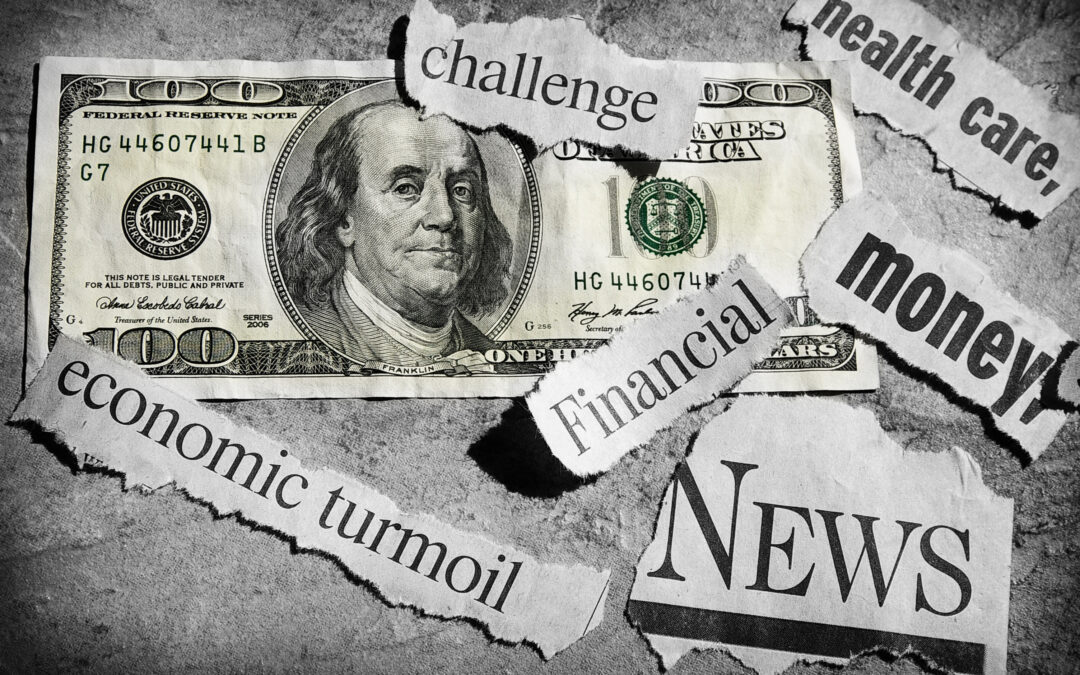This week, the U.S. federal government is back to business as usual after the longest shutdown in our country’s history.
That means we’re about to see the first official economic data to come out of the government since September — and I think most folks are going to be surprised by what they see.
With just three weeks left before the next meeting of the Federal Open Market Committee (FOMC), where Federal Reserve Chairman Jerome Powell and his colleagues will decide the fate of the financial world, I think we might have a case of “too little, too late.”
Hit this week’s video below for the full story:
Video transcript:
This is Moneyball Economics. I’m Andrew Zatlin, and welcome to part two of our two-parter.
We are exploring what happens now that the government is back in order and the economic data is flowing again.
In part one, we talked about what is the impact of the data on the Federal Reserve decision in December to cut interest rates. My view is that it’s too little, too late, and the Fed is probably going to be more inclined to kick the can than not. And in fact, the market is starting to wake up to that view at the same time. In part two, we want to talk about, well, once that economic data does start to flow, what story is it going to tell? What picture is it going to paint?
And I think it’s going to paint a relatively benign and even bullish picture. And again, that’s not something the market wants to see because the better the economy looks, the less likely we’re going to see a lot of interest rate cuts.
So with that in mind, let’s talk about why I think we’re seeing some benign and even bullish data. And to do that, we’re going to talk about what are companies experiencing, because at the end of the day, it’s all about companies. If they’re experiencing positive things, they’re going to start hiring more. They’re going to start spending more. Economic activity will pick up.
So I’d like to explore what the companies are seeing today, what corporate experiencing, and introduce some data that shows you how that information is translating into their hiring. Because right now, I think hiring’s about to go up and I’m going to show you why, but for starters, let’s talk about what corporate America has been experiencing the past year. Even before Trump took charge in January, corporate America was in a layoff cycle. And let me explain why it all comes down to corporate profit growth.
If companies are growing, well, first of all, that points to a demand for more staff to support that growth. And if they’re growing and profits are growing, then that supports the ability to do things like hiring and spend on CapEx. Well, that’s exactly where companies weren’t starting last year.
We saw a dramatic fall off in corporate profitability and revenue growth, specifically when we were in the second quarter last year in the run up to the election, we were looking at about 10 to 11% quarterly growth in corporate profits. That’s phenomenal, except when we got to the third quarter, it fell to closer to 4% and was falling even more dramatically. In other words, by the end of last year, companies had to lay off workers simply put to maintain their profit growth, and that wasn’t just a one quarter event, it bled into the first quarter.
Key point here is companies coming into 2025 were not in a particularly expansionary mode to begin with, and now you bring Trump into the mix where he’s throwing tariffs out, creating a lot of uncertainty wherever he’s going. Well, at that point, companies said not only are we are on a cyclical down slope, we now have this Trump tariff factor.
Why don’t we just not invest until the smoke clears? And that’s pretty much what happened for a long time. I’m going to come back to the hiring and what’s been changing, but suffice it to say, coming into the third quarter, a full year now of falling profit growth. What do we know?
Well, the last government data showed us that by the second quarter, all of these layoffs that happened in the fourth quarter and the first quarter were starting to pay off. What we see in the second quarter is a slight rebound in profitability, but it’s more stemming the bleeding than anything else.
And let’s face it, that’s up through June. I mean, we’re standing here in November. That’s old. What we want to know is what happened in the third quarter and what happened were three things. First of all, it’s obvious that interest rates are going down, and that’s always stimulative to the economy, and that’s good news for companies.
So we’re going into a lower interest rate environment, but another condition that makes companies more willing to invest and expand is inflation. We don’t have CPI and PPI for two months now. We don’t know what’s going on, but we do know that it was kind of sort of flat as we came into the October shutdown, so into August and September. Inflation was not the boogeyman that it was being painted out to be. Remember when Trump came in throwing tariffs out? Everyone sat back and said, wait a second.
This can’t be good.
We have a slowing economy. It looks like now we’re going to raise inflation by raising the cost of imports. We’re looking at maybe stagflation. The Fed started talking about that. Corporate America heard and said, Hey, this is scary. Inflation’s scary. Well, it turns out the academics were mostly wrong because a lot of the tariffs didn’t actually happen. They were absorbed by our trading partners. Or quite frankly, it just gets diluted as it moves through the system.
So inflation’s been pretty tame. Companies like that, interest rates coming down, inflation looking tame. But what do we know about the last two months because we don’t have the data? Well, again, we can look at alternative data. We can look at oil prices right off the bat. Oil prices have been hugely falling. They’ve fallen 15% over the course of the last year from $70 in January, February.
Now down below $58, oil has been falling. In fact, oil prices are the lowest they’ve been since 2021. So we now have an environment of falling costs of deflation, not inflation, and not disinflation. Actual prices coming down. And you might’ve heard the Trump administration try to say, oh, and it’s happening with food as well. Well, a lot of academics at this point will say, wait a second, changes in oil and food, we need to ignore that.
When we look at inflation, we need to look at the other stuff and they’re wrong for two reasons. If you hear that reason number one, this isn’t a month to month volatility, oil prices have been steadily dropping for 10 months. That’s not a small thing. That’s trend. And so you want to look at that trend and we’re not talking about what consumers are paying at the pumps.
That’s nice. Consumers are saving a few bucks, putting in their pockets. We’re talking about the way and the fact that our economy depends on oil. So even though we have this headline thing within inflation that says oil, we also have oil popping up in other places. We have something, for example, in the inflation calculator relating to transportation service prices. Well, that’s basically insurance and oil costs that Amazon pays for their couriers, that truckers pay and so on and so forth. Oil is very impactful both directly as a single line item and then throughout the other parts of inflation.
So no, we can’t ignore what’s going on with oil and it’s crashing and it’s pulling down inflation with it. And so again, what are companies seeing? Well, they’re seeing that they aren’t really in a hugely inflationary environment. Wages are only going up. Again, the standard three and a half, 4%, so they’re not getting labor inflation by and large companies are sitting there saying the business climate’s pretty good.
And oh, by the way, consumer spending seems to be pretty strong. Again, we don’t have the latest retail data, but coming into holiday season, we did have some data from the government that said spending still strong, and then we have the National Retail Federation coming out and saying, wow, spending for Halloween was good. Spending for the coming season looks pretty tidy.
Again, going back to what is the overall environment today for a company? They’re only seeing good things. Aha. You take this steady growth, you take low inflation falling interest rates, and now you look at what their performance was in the third quarter. Again, we don’t have visibility yet to the corporate profits and the data coming out of the government, but we did just finish the earning cycle, and the earning cycle was fantastic. What we found is that third quarter profits surged, revenue grew and looking at the fourth quarter and then looking at next year, companies are expecting both top line and bottom line growth.
So what do we have? Then? We have companies basically coming back after the summer vacation looking around, seeing nothing but positives. And this is where I want to share this data with you. This is my own proprietary data.
What I do is I collect every week, actually every day data of sort of small businesses, less than a hundred person businesses. They’re hiring on a daily basis. And what I do with that is I collect it across about 60 cities in the United States, and I’ve been doing this for over a decade. I’m going to share with you three years, the last three years of this data, it’s not seasonally adjusted.
So you’ll see for example, in January, nobody’s hiring, and then as we get into the spring and summer, hiring perks up, and then the last half of the year, again, hiring starts to slow. But what you should notice from these lines, when you look at this year, a couple of things, you’ll see that last year and this year, there was a sharp pullback in which we know, but what I want to share with you is I believe that given everything that companies knew in the first half of the year, they knew that their profits were going down, business activity was going down, and the tariffs were causing problems.
They hit the brakes on hiring, but I think they overreacted, and I think when they came back in August, they realized they overreacted because simply put, they hadn’t hired for about five, six months and as a result, business kept going and going and going, and now they needed employees. And so they’ve been looking at this a little bit and starting to hire again, and that I think is what we should expect.
The other thing is when you look at this data, understand that the reason I like to look at these smaller businesses, well, several reasons. I think this is a true signal. Again, I’m the number one jobless claims and number one payroll guy out there. I rely on data like this to know what’s going on in the broader economy. But this particular subset of data is really cool because when you’re talking about small businesses, number one, they’re closer to the customer.
It doesn’t take a lot of time for them to sense growth or fall off. So they’re going to respond quickly and not just because they’re close to the customer, they’re going to respond quickly to any shift in the economic wins because they have to. These are companies that don’t necessarily have deep pockets, they don’t have large lines of credit. They have to take action when they need to. In addition, not only do they have to take action, but you’ll see action happening.
You’ll see them react faster because they can, A lot of their employee base are hourly workers where they can let them go at will, and so they don’t have an intel, I got to give you three months of severance and things like that. They can grow or shrink very quickly. What I like about this data point is we’re seeing a couple of things in the past couple of months with the government shutdown.
You can see that there’s a sharp drop off over the past couple of months. What you’re seeing is a reaction to the government shutdown, but you’re also seeing now that the latest look of this data shows that their hiring level is basically where it was last year and the year before. That’s huge. Even with the government shutdown, we’re seeing hiring at the same level.
Now, imagine us coming out of the government shutdown. What I think we’re going to see in the next week or two is that this year’s fourth quarter hiring is going to exceed last year’s hiring. And that’s huge. That will tell us that yes, in the fourth quarter we’re transitioning. We’re transitioning away from running into the fourth quarter. Companies overreacted. They stopped their hiring, but now they see that business conditions are ripe. They’re very good, and they got to replenish their people, and that’s what they’re doing in the fourth quarter.
The question though is what comes next? Is this just replenishment, Hey, a zig to a zag, we went too far this way, now we got to pull back this way. Or will it go beyond the replenishment? Remember I said that the last quarter of earnings was very positive, guidance was raised. So if you’re looking around and you’re hanging out with your other CEO buddies and everybody’s raising their guidance, that business is going to take off next year. And that indeed is what I think corporate America is expecting.
And so we’re going to see very little hiring as we close out the year. A more leaning in of hiring, excuse me, very little firing, more leaning in of hiring. And that’s going to also start to get into a positive feedback loop next year. So when we get into the first quarter, which is when we should start to see the hiring wave begin, because let’s face it, you don’t hire as you go into Thanksgiving, you don’t hire as you go into Christmas.
People are going on vacation. They’re not starting new projects. That’s a January February thing.
So I think next year companies are in a position where they’re saying, Hey, the overall business climate is calm, low inflation. It’s a good environment to invest. We see demand picking up, and let’s face it, by January, February, it’s been a year of craziness with the tariffs. We see the tariff thing resolving itself, and now we’ve got conditions that are positive for United States based companies and for employment.
So I think there’s going to be a surprise out there that we are going to see 2026 being a boom year, and that’s before we start trotting out the Trump things like is there going to be a $2,000 dividend payout thanks to this tariff that he’s been collecting? We also know in April we’re going to see, what is it? I think I’ve read $3,500 per household in reduced taxes as of April.
So we’re going to see a lot of money, a highly stimulative fiscal policy, and where that goes, we’ll drive up the economy and where the economy goes, you can expect the stock market to go. So the data coming out again, is going to be transitionary data. I think it’s going to point to a firming up of the economy. I don’t think it’s going to say to the Fed, it’s firm enough where you don’t cut rates. But I do think it makes the fed think twice going forward into next year.
We’re it to win it folks.
Zatlin out.

Andrew Zatlin
Editor, Moneyball Economics





